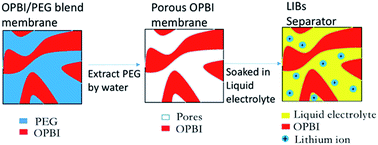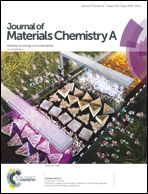A simple approach for preparation of porous polybenzimidazole membranes as a promising separator for lithium ion batteries†
Abstract
A simple and controllable approach has been developed for the preparation of a series of poly(2,2′-(p-oxydiphenylene)-5,5′-bibenzimidazole) (OPBI) porous membranes with controlled porosity and pore size. The micropores were formed by simply extracting poly(ethylene glycol) (PEG) from the dry OPBI/PEG blend membranes with water. The effects of PEG molecular weight (Mw = 350–10 000) and PEG weight fraction (OPBI/PEG = 1 : 1–1 : 5) on membrane morphology and properties were investigated. It was found that higher Mw and weight fraction of PEG in polymer blends tended to give higher porosity but lower mechanical strength. The porous membrane, M-4, prepared from PEG10000 (Mw = 10 000) at a weight ratio of OPBI/PEG10000 = 1 : 5 exhibited a high porosity (71%), a high ionic conductivity (1.3 mS cm−1 at room temperature), and reasonably high tensile strength (10 MPa). Furthermore, M-4 showed only ∼5% thermal shrinkage after heating at 200 °C for 1 h and good fire-retardant properties which were much better than those of the commercial separator Celgard 2400. The charge–discharge cycle test and C-rate performance test results revealed that M-4 was a promising candidate as a separator for lithium ion batteries.



 Please wait while we load your content...
Please wait while we load your content...